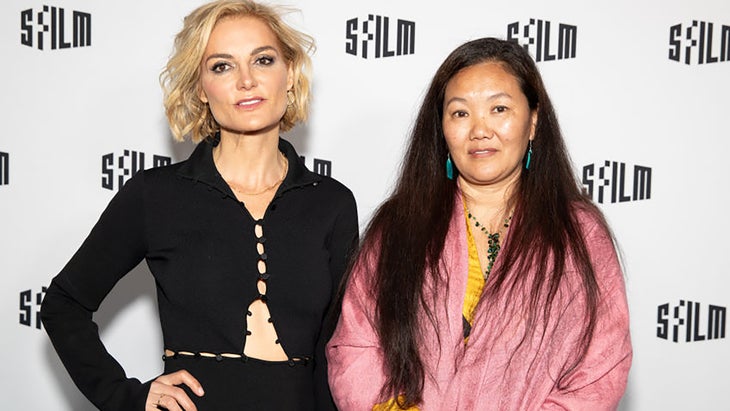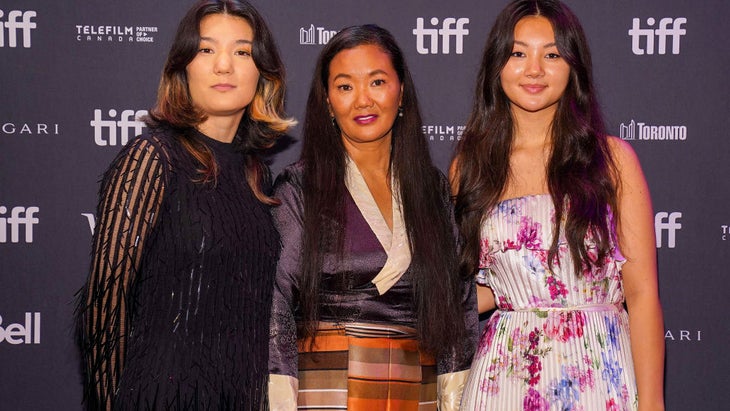Mount Everest has provided the dizzying backdrop for numerous documentaries about famous mountaineers—think Sherpa, Finding Michael, and of course 14 Peaks: Nothing Is Impossible. The latest addition to the oeuvre, called Mountain Queen: The Summits of Lhakpa Sherpa, is one of the best. Mountain Queen chronicles the life of pioneering Nepali climber Lhakpa Sherpa, who has ascended Everest ten times, the most of any woman. The film will air on Netflix starting July 31.
The film follows Lhakpa Sherpa on her tenth ascent of the peak, which occurred in 2022, but it also places a microscope on her life away from the Himalayas. Cameras show the 51-year-old climber living in a cramped apartment in Connecticut with her two teenaged daughters, and also show her stocking shelves and cleaning floors at Whole Foods. File footage shows Lhakpa’s impressive life trajectory: she was born to a single mother in a cave, worked as a janitor and a camp cook, and eventually became the first Nepali woman to ascend the world’s highest peak. And raw interviews explore Lhakpa’s relationship with her abusive ex-husband, Romanian climber Gheorghe Dijmarescu.
The film is the brainchild of Oscar-nominated director Lucy Walker, whose 2006 film Blindsight chronicled six blind Tibetan teenagers who ascend Everest’s north side. We asked Walker why she was so committed to telling mainstream audiences about Lhakpa Sherpa.

OUTSIDE: What drew you to Lhapka Sherpa’s story?
I’m always looking for stories where I’m the right person to tell them. I didn’t expect to make another Everest film after Blindsight, but I know how to shoot the mountain after that experience. I’m always on the lookout for character-driven longitudinal documentaries—films that trace the life of an incredible person. Where, if you put enough years together and edit them together thoughtfully, you can really illuminate the journey of a special person. I wanted to give that to Lhakpa. After meeting her back in 2004 and then reading more about her story I thought, “this film has to be done and it has to be done beautifully.” Here she is, this person who set out to inspire women and girls to get an education and to pursue their own dreams, and to not settle for expectations. As a girl she cut off her hair and passed herself off as a boy in order to do a male job. As a person who is in a male-dominated field, that related to me. I’m always in awe of people who are champions and who have tried to make the world better, and Lhakpa has really done that. I set out with this vision of the summits of Lhakpa—you could tell the story of a whole life by the mountains she’s climbed, both on mountains and in life. There wasn’t anybody else who was going to do justice to her story, and I really felt she deserved to have her story told.
There’s a lot of file footage from the early 2000s in the film. How did you track all of that down?
I knew there would be movie footage out there of her first few ascents in the early 2000s, but Lhakpa had none. I had to search everywhere: Romania, the USA, Nepal. We turned over every stone in every attic. Great footage came from a garage in Boulder, Colorado, from author Michael Kodas, who had videos from her 2004 expedition. I had already been working on the film for several years before he consented to let us use the footage and to interview him. He told me it was video nobody had ever seen—and sure enough, it tells the story of this argument with Gheorghe that becomes this big dramatic moment in her life. I also knew there was footage from her first expedition, back in 2000. I’m a crazy optimist, and I just thought that if I could gather those materials to tell her backstory, and use my knowledge of how to shoot an Everest climb, and to then tell the story of the journey she goes on to Nepal to try and inspire her own daughters—who we see are really in need of some inspiration—then we had the ingredients for a film. I looked around at the landscape and just thought ‘this has to be done, and it has to be done by me.’
Making a film for Netflix means trying to reach a broad and mainstream audience. What challenges did this present when telling Lhakpa’s story?
We did not set out to make a film for Netflix. This isn’t some well-funded project—this film is the product of a mountain of work that was done by really passionate people who were as inspired and determined as I was to do justice to Lhakpa’s story, even on a relatively shoestring budget. We were thrilled when Netflix picked it up so that Lhakpa could have a worldwide audience. The challenge is that Lhakpa is not well-known. Aside from the Outside article, she didn’t get much coverage. There was a lovely recent piece in The New York Times. Most people are familiar with Everest because of the men who climb it, or the male Sherpas, or the rich tourists. And here is this woman who has climbed it ten times without a cent in her pocket to pay for it. And to tell her full story, ten Everest summits, a life in the mountains, and to weave all of that together in a way that goes beyond mountaineering, I wanted audiences to have all of that.

In the early scenes, Lhakpa’s daughters, Sunny and Shiny, seem unenthused to be part of a documentary. How did you convince them to participate in the film?
To be fair, I had to work on Lhakpa as well to be part of the film. Her goal of telling her story was to inspire girls and women to dream big. But it’s one thing being filmed on top of Everest, and it’s another thing to be open and vulnerable and to let people into your life story—specifically when your story includes the trauma of being the victim of intimate-partner violence. It’s such a fiendish situation, and Lhakpa was still so gracious about Gheorghe Dijmarescu and wanted to create a nuanced portrait of him. And the girls still love him as their dad. I wanted to capture this complicated situation—there’s no arguing how traumatized they all were. Being able to share that side took a lot of trust building and patience. For example, I did three interviews with Lhakpa in Kathmandu, and she didn’t want to mention anything about Gheorghe. She’d just skip the bad years and talk about the happy bits of their marriage. Slowly, she’d get to the difficult parts. She was going through a tough time, and so were the girls, particularly Sunny. At the start of filming she was catatonic. It wasn’t that she didn’t want to speak to me—she was barely talking to anyone. I didn’t know that, eventually, she would become so inspired by her mother. She eventually started speaking, and then one amazing evening when we were at the apartment, she comes out of her room and I could just tell she was moving differently. We grab the camera and start rolling, and flicked on the lights, and she starts telling her mom “with every step on the mountain, you were inspiring me.” It was this beautiful moment that we were lucky enough to capture.
Do you think this film will change Lhakpa’s financial situation?
Yes, I know it will. We have a robust campaign alongside the film that is committed to both Lhakpa and her family. When you ask her what she wants the film to accomplish, she will talk about helping others. She wants women from rural regions to be inspired to get an education, and to teach women about the health benefits of the outdoors. She has selfless goals. But we are working with her so that her life can be transformed.
This interview has been edited for clarity and length.






